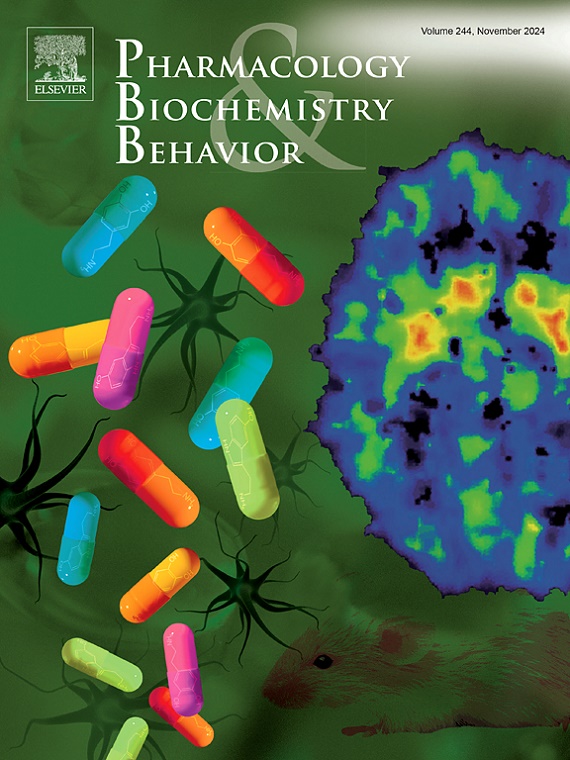左旋多巴通过侧链Kv7.2亚单位的m通道逆转实验性帕金森病受损的工作记忆。
IF 3.3
3区 心理学
Q1 BEHAVIORAL SCIENCES
引用次数: 0
摘要
认知缺陷等非运动症状在帕金森病中经常被观察到,l -3,4-二羟基苯丙氨酸(L-DOPA)治疗对单侧6-羟多巴胺损伤黑质致密(SNc)大鼠工作记忆的影响及其机制尚不清楚。在成年雄性Sprague-Dawley大鼠中,我们发现,与生理盐水(NS)治疗的snc损伤大鼠相比,L-DOPA治疗可以逆转工作记忆障碍,降低外侧链束(LHb)神经元的放电率,增加内侧前额叶皮层(mPFC)和海马的多巴胺(DA)水平,逆转LHb中m通道Kv7.2亚基的表达降低。在lhb内注射m通道激活剂瑞gabine或阻滞剂xa -991可诱导L-DOPA治疗snc损伤大鼠的工作记忆增强或受损,同时mPFC和海马中的DA水平发生改变。然而,相同剂量的两种药物对NS治疗的snc损伤大鼠的工作记忆和DA水平没有显著影响。此外,m通道激活或阻断降低或增加了LHb神经元的放电速率,并且L-DOPA处理的snc损伤大鼠的m通道刺激对神经元放电速率的持续时间比NS处理的snc损伤大鼠更长,这与LHb中Kv7.2亚基的上调一致。综上所述,左旋多巴可上调LHb中m通道Kv7.2亚基的表达,进而导致LHb神经元活性降低,mPFC和海马中DA水平升高,从而逆转帕金森大鼠的工作记忆障碍。本文章由计算机程序翻译,如有差异,请以英文原文为准。

L-DOPA reverses the impaired working memory via lateral habenula Kv7.2 subunit-containing M-channels in experimental parkinsonism
Non-motor symptoms such as cognitive deficits are often observed in Parkinson's disease, and the effect of L-3,4-dihydroxyphenylalanin (L-DOPA) treatment on working memory in rats with unilateral 6-hydroxydopamine lesions of the substantia nigra compacta (SNc) and underlying mechanisms are unclear. In adult male Sprague-Dawley rats, we found that L-DOPA treatment in SNc-lesioned rats reversed working memory impairment, decreased the firing rate of the lateral habenula (LHb) neurons, increased dopamine (DA) levels in the medial prefrontal cortex (mPFC) and hippocampus, and reversed reduced expression of M-channel Kv7.2 subunit in the LHb compared with SNc-lesioned rats treated with normal saline (NS). Intra-LHb injection of M-channel activator retigabine or blocker XE-991 induced enhancement or impairment of working memory in SNc-lesioned rats treated with L-DOPA, along with alterations of DA levels in the mPFC and hippocampus. However, the same doses of the two drugs produced no significant effects on working memory and DA levels in SNc-lesioned rats treated with NS. Further, M-channel activate or blockade decreased or increased the firing rate of LHb neurons, and the duration of M-channel stimulation on the firing rate of the neurons in SNc-lesioned rats treated L-DOPA was longer than those in SNc-lesioned rats treated with NS, which was consistent with up-regulation of Kv7.2 subunit in the LHb. Collectively, these findings suggest that L-DOPA treatment up-regulates the expression of M-channel Kv7.2 subunit in the LHb, and then induces decreased activity of LHb neurons and increased DA levels in the mPFC and hippocampus, which reverse working memory impairment in parkinsonian rats.
求助全文
通过发布文献求助,成功后即可免费获取论文全文。
去求助
来源期刊
CiteScore
6.40
自引率
2.80%
发文量
122
审稿时长
38 days
期刊介绍:
Pharmacology Biochemistry & Behavior publishes original reports in the areas of pharmacology and biochemistry in which the primary emphasis and theoretical context are behavioral. Contributions may involve clinical, preclinical, or basic research. Purely biochemical or toxicology studies will not be published. Papers describing the behavioral effects of novel drugs in models of psychiatric, neurological and cognitive disorders, and central pain must include a positive control unless the paper is on a disease where such a drug is not available yet. Papers focusing on physiological processes (e.g., peripheral pain mechanisms, body temperature regulation, seizure activity) are not accepted as we would like to retain the focus of Pharmacology Biochemistry & Behavior on behavior and its interaction with the biochemistry and neurochemistry of the central nervous system. Papers describing the effects of plant materials are generally not considered, unless the active ingredients are studied, the extraction method is well described, the doses tested are known, and clear and definite experimental evidence on the mechanism of action of the active ingredients is provided.

 求助内容:
求助内容: 应助结果提醒方式:
应助结果提醒方式:


